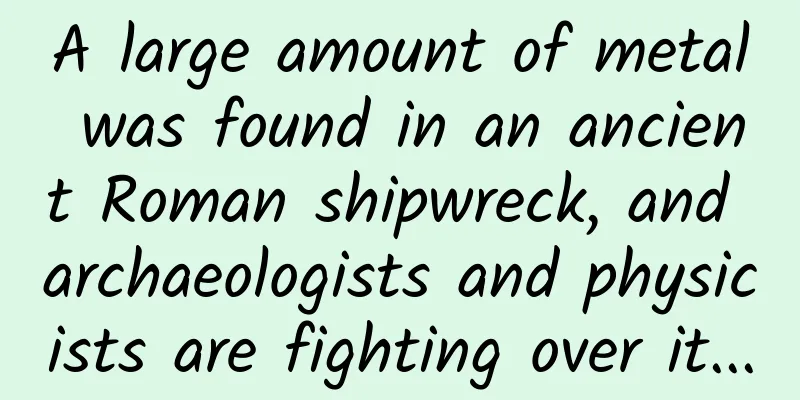A large amount of metal was found in an ancient Roman shipwreck, and archaeologists and physicists are fighting over it...

|
In 1988, about 10 kilometers off the coast of Sardinia, Italy, divers were diving to find the remains of a shipwreck. When they dived to a depth of 28 meters, they suddenly found the outline of a shipwreck. Since the dawn of the Age of Exploration, the ocean has swallowed countless ships. These shipwrecks contain treasures and history from different eras, and each discovery is of great interest to marine archaeologists , who have the best clues to reconstruct the past. Based on the shape of the pottery on the ship, archaeologists determined that it was an ancient Roman shipwreck . The ancient Roman civilization is more than 2,000 years old. Time and seawater have destroyed most of the wooden structures, but some corrosion-resistant stone and metal products are still well preserved. Although it is not surprising to find ancient Roman shipwrecks on the seabed near Italy, this ship is very special. It is much larger and stronger than most shipwrecks. Lead ingots recovered from a shipwreck in the waters off Sardinia. Image source: Reference [9] Archaeologists discovered the reason why the ship was so strong - the ship was loaded with a large number of metal bars, more than a thousand lead ingots , or about 33 tons of metal, the largest amount of metal ever found in a shipwreck excavation at the time. Archaeologists were undoubtedly very surprised by these heavy "treasures"! Suspiciously, physicists were equally excited. Lead in Archaeology Each of these lead ingots is roughly trapezoidal in shape, 45 cm long and weighs about 33 kg, so they were still neatly stacked when they were discovered. Lead was a very important metal in ancient Rome, and was cast into water pipes, coins, weapons or building structures. Although the specific use is unknown, the discovery of this large number of lead ingots also confirms the strong manufacturing capabilities and developed economic trade of ancient Rome. The inscriptions and trademarks engraved on the lead ingots also allow archaeologists to peek into the technology, industry and cultural history of the lost civilization. Ancient Roman lead water pipes (1st century), photographed at the Grosvenor Museum. Image credit: Wolfgang Sauber/Wikipedia Most ancient lead ingots were salvaged from deep-sea shipwrecks, but some were buried in the soil. A study published in the Journal of Roman Archaeology in May this year conducted a detailed examination of three lead ingots unearthed from the Belmes site in Cordoba, Spain in the 20th century. By analyzing the chemical composition and stable isotopes of the lead ingots, the researchers found that the three lead ingots were produced from the same mining area, and two of the lead ingots with the letters "SS" were from the same mining company, "Societas Sisaponensis", which is headquartered in Cordoba. The results of the test on the lead ingots from the shipwreck showed that more than half of the lead ingots were mined from this mining area. The latest research results seem to further confirm that Cordoba may have had the most important metallurgical network in the ancient Mediterranean region, and also reflect the possible level of industrialization at that time. Lead ingots can help archaeologists connect the history of the Mediterranean region . Obviously, they would like to keep all the lead ingots they have found, or send them to museums for safekeeping for future in-depth testing and analysis. But the physicists who are "peeking" on the side don't think so. What they want to do most is to melt these Roman lead ingots and use them to explore the mysteries of the universe. Lead in Physics After reading about the discovery of the giant cargo ship in a newspaper in 1988, Ettore Fiorini, a physicist at the University of Milan-Bicocca in Italy and experimental coordinator of the Cryogenic Underground Observatory for Rare Events (CUORE), immediately foresaw the importance of these lead ingots for physicists (particle physicists, to be more precise). At the time, the Italian National Institute for Nuclear Physics (INFN) was building the CUORE detector underground at the Gran Sasso laboratory. The goal of the experiment was to search for a theoretical particle decay event called neutrinoless double beta decay . Standard double beta decay releases two neutrinos, but in neutrinoless double beta decay, the nucleus only releases two electrons, without neutrinos. Even in theory, neutrinoless double-beta decay events are rare and we have never observed them, but if we could actually observe them, we might be able to measure the mass of neutrinos, answer the question of whether the antimatter of neutrinos is themselves (Majorana neutrinos), and possibly reveal the mystery of the asymmetric distribution of matter and antimatter in the universe. Feynman diagram of neutrinoless double beta decay. Image credit: CUORE/INFN In order to observe this rare decay event, CUORE scientists need to build a tellurium dioxide cube weighing about 750 kilograms 1,400 meters below the rock. Because such events are extremely rare and the signal is very weak, this experiment (and similar experiments) must be strictly isolated from the influence of any external radioactive events and keep the background radioactivity to a minimum - this is where Roman lead comes in. The entire CUORE is built underground, protected by 1.4 km of mountain rock to prevent the impact of cosmic neutrino background radiation, but this is far from enough. Because the rock used to protect the experimental facilities is also slightly radioactive, CUORE also needs a "shield" that strictly shields radiation. The nucleus of lead is large and heavy, so only a thin layer is needed to prevent many tiny particles from penetrating. Ideally, pure lead is suitable for radiation shielding. Rendering of the CUORE cryostat detector, including the pulse tube, dilution refrigeration unit, internal low-radioactive modern and Roman lead shielding, and the tellurium dioxide crystal array (light blue). Image source: Reference [9] But the reality is not ideal. All newly mined lead in nature contains a certain amount of the radioactive element uranium-235, which decays over time into the unstable isotope lead-210, which decays into the more stable isotope with a half-life of 22 years. Although the process of processing lead ore removes most of the uranium, the lead-210 that is already present still emits weak radiation over the years. Obviously, lead itself has become a source of radiation in reality and cannot be used directly as a radiation shield for particle physics experiments. However, lead that has been submerged underwater for thousands of years has almost completely lost its natural radioactivity over a long period of time, making it a perfect material for shielding particle detectors. In 1991, the INFN team and collaborators tested the radioactivity of Roman lead in detail in a paper (Fiorini was a co-author). Various detection methods showed that Roman lead did not contain lead-210 at all, and the background radiation level was only about one thousandth of that of modern lead, making it the best shielding material among the research samples at the time. In 2019, a study published in The European Physical Journal A further tested the radioactive purity of Roman lead samples using the latest low-temperature detection technology and reported the lowest lead-210 measurement limit ever. "Particle physicists often look for low-level radioactive lead," Fiorini said. "The metal is often extracted from the roofs of ancient churches and the keels of sunken ships for use in experiments." However, the discovery in Sardinia is unprecedented in both its age and the richness of the material. Archaeology vs Physics In 1991, after learning that the archaeological institute in Cagliari did not have enough money to salvage all the lead ingots from the seafloor, Fiorini persuaded INFN managers to donate about $210,000 to the effort. In exchange, the physicists would be able to use some of the recovered Roman lead. In the 1990s, INFN experiments used some lead ingots, and in 2010 the Grancastle laboratory received another four tons of Roman lead from a museum in Sardinia. The inscription on the lead ingot was cut and preserved, and the remaining bulk was used for the lead shielding inside the CUORE. Image source: Reference [9] Archaeologists at the Cagliari Museum said that parting with these ingots was very painful. Although the ingots handed over to INFN were the worst preserved, they still have extraordinary historical value. Fortunately, physicists will cut off the inscriptions before melting the ingots and send them back to Cagliari for preservation. The remaining ingots will be melted together with the previous lead into a 6-centimeter-thick lead lining to wrap the CUORE detector. Right side view of the lead shield inside the CUORE. Image source: Reference [9] Many archaeologists have expressed opposition to the casting of these historic lead blocks. Elena Perez-Alvaro, a doctor of cultural and natural heritage management, once questioned: "Are these experiments important enough to destroy part of the past to discover the future?" M. Fernando Gonzalez-Zalba, a physicist at the University of Cambridge in the UK, said: "These experiments can explain some of the most basic properties of the universe, and I think it is worth it." Roman lead isn't the only material that meets the requirements of sensitive experiments. Ancient Greek civilization also used this building material. Greek lead is more scarce, but Roman lead is not in sufficient supply. Archaeologist John Carman said that if physicists use it more widely, archaeologists may lose all ancient Roman lead , and thus lose all the information it can provide about the technology, culture and industry of the Romans. There is no clear legal text on the dispute. The 2001 UNESCO Convention on the Protection of the Underwater Cultural Heritage prohibits the commercial exploitation of historic shipwrecks, but it is unclear whether it applies to physical experiments. Searching without results Although the specific details are unclear, judging from the results, the dispute was eventually settled with compromises by all parties - the CUORE team used Roman lead to recast radiation shields, their experimental instruments began collecting data in 2017, and announced the latest results in 2022. Unfortunately, they did not find any traces of neutrinoless double beta decay. Currently, INFN is trying to upgrade CUORE to CUPID (CUORE Upgrade with Particle Identification), adding particle identification capabilities. The best news for archaeologists is that this upgrade does not require additional Roman lead. Interestingly, while CUORE’s primary scientific goal is to search for evidence of Majorana neutrinos, its ability to identify and measure low-energy events also makes it well suited for exploring dark matter—astrophysical observations at various scales suggest that 27% of the universe is made up of undiscovered dark matter, but we have yet to unravel the mystery of what dark matter is. References [1]https://cuore.lngs.infn.it/en/news [2]https://www.lngs.infn.it/en/cupid [3]https://wlab.yale.edu/news/ancient-roman-shipwreck-may-explain-universe-cuore-and-cupid-experiments-featured-scishow [4]https://www.youtube.com/watch?v=o0A9M5wHBA4 [5]https://www.scientificamerican.com/article/roman-ingots-to-shield-detector/ [6]https://www.scientificamerican.com/article/ancient-roman-lead-physics-archaeology-controversy/ [7]https://scitechdaily.com/lost-treasures-of-rome-lead-ingots-unearthed-in-cordobas-ancient-mines/ [8]https://www.cambridge.org/core/journals/journal-of-roman-archaeology/article/la-societas-sisaponensis-los-lingotes-de-dona-ramabelmez-y-la-explotacion-minera-de-los-montes-de-corduba/390278955EB173651F606DBCD365AFE8 [9]https://doi.org/10.1038/s41586-022-04497-4 Planning and production Source: Global Science (ID: huanqiukexue) Author: Bu Zhou Editor: Zhong Yanping Proofread by Xu Lailinlin |
>>: World Food Day丨What should humans do if there is not enough food?
Recommend
8 key points of Weibo operation, everything you don’t know is here!
1. What does Weibo real-time account mean? Weibo ...
Practical application of user experience optimization on special effects side - Package size
1 The size of special effects packages for TikTo...
What is server hosting?
What is server hosting? In general, server rental...
Electricity is cheaper than oil. Double glory in the ocean. BYD Song PLUS Glory Edition and Seal DM-i Glory Edition are launched
On February 29, BYD Song PLUS Honor Edition and H...
Uncovering the true face of the Milky Way: Exploring how we describe the entire picture of the Milky Way
How do we know what the Milky Way looks like? - I...
Do you drink a bottle when you are tired, sleepy, or driving late at night? This "one bottle" may damage your blood vessels and make you fat!
"Have a bottle when you are tired or sleepy,...
A strange sight on the streets of Beijing: Mushrooms are smoking!
Review expert: Ji Hongzeng, PhD candidate in Powe...
Is it good for your health to swallow the phlegm?
Expert of this article: Wang Qian, attending phys...
The right bank of the Irtysh River: the colorful hill
Most of the rivers in Xinjiang are inland rivers,...
Why do you always feel that the way out is long, but the way back is short? This may be a good omen for traveling!
"Why hasn't it arrived yet?" "...
Why are mobile phones so expensive nowadays?
When we read information about mobile phones, we ...
2018 JD.com "618" promotion gameplay revealed
This year's " JD 618 " event is qui...
SAIC Motor delivered 750 “government reception vehicles” to the CIIE
(October 12, 2024, Shanghai) Today, the "Del...









